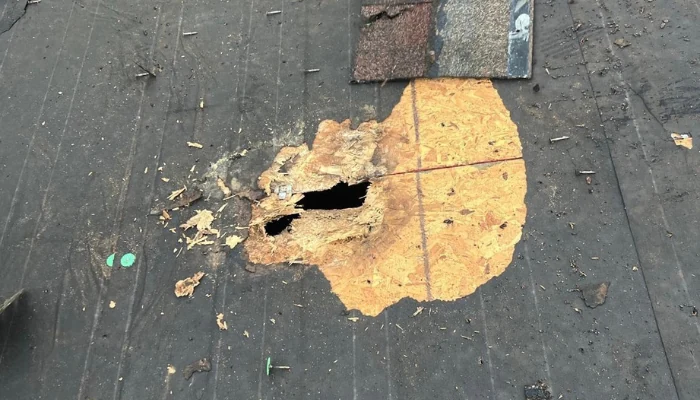When disaster strikes, time is everything. Emergency roof tarp solutions aren’t just a quick fix; they’re the first line of defense to stop water damage and protect your home’s structure.
In Florida, where hurricanes and sudden storms can rip off shingles in minutes, knowing your options can mean the difference between a quick patch and a costly repair.
Did you know that water intrusion after a storm can cause structural damage claims in coastal areas? Thousands of homeowners trust professional emergency roof tarp services to keep their homes dry and safe until permanent repairs are possible.
In this guide, we’ll walk you through everything you need to know about emergency roof tarping: When and why you need it, how it’s done safely and effectively and why trusting professionals like Protect Preserve Roofing can save you headaches later.
Don’t miss this chance to protect your home with the most trusted roof tarping services in Florida. Let’s dive in.
Table of Contents
ToggleUnderstanding the Importance of Emergency Roof Tarping
Emergency roof tarp installation is a fast and effective way to protect your home from further damage after a storm or accident.
When heavy rain, hail or strong winds hit, your roof can lose shingles or tiles, exposing the interior to water leaks. This kind of damage can quickly lead to mold, weakened structures, and costly repairs.
The tarp acts like a temporary shield. It stops rain from entering your home and prevents bigger issues from starting. It’s a simple solution that buys you time until you can arrange for permanent repairs.
In Florida, where hurricane season can be brutal, using a tarp is a step even more important. Thousands of homeowners each year rely on tarping to keep their homes safe and dry until the full repair is possible. It is a valid and well-known major damage prevention system.
Have you ever had to deal with a leaking roof after a big storm? It’s stressful and risky. That’s why Protect Preserve Roofing focuses on fast, reliable tarping services in Florida. We know how to keep your home safe and your insurance company happy.
Also read:
Assessing Roof Damage: When and Why to Act Quickly

You should act fast when you see signs of roof damage. Missing shingles, water spots on your ceiling or pieces of roof material on the ground mean trouble. Even small cracks can lead to big problems if water gets inside.
Why act quickly? Because water damage spreads fast. It seeps into walls, damages insulation and can even reach electrical systems. Mold grows in damp spots within 24 to 48 hours. Fixing a leak early saves money and protects your home.
A quick roof inspection can show you how bad the damage is. Use binoculars to spot missing shingles or sagging parts. If you feel unsure or see signs of bigger issues, call Protect Preserve Roofing. We’re ready to tarp your roof fast and keep the damage from spreading.
Step-by-Step Guide to Emergency Roof Tarp Installation
Putting up a tarp is more than just throwing it over your roof. It needs to be secure to handle rain and wind. Here’s how it’s done the right way:
- Check the damage: Look for loose shingles, holes, or broken tiles. Make sure the area is safe before you start.
- Gather your tools: You’ll need a heavy-duty tarp, sandbags and a sturdy ladder. Avoid using nails or screws.
- Get help: Tarping alone is dangerous. Have a friend or someone hold the ladder and hand you tools.
- Place the tarp: Lay the tarp over the ridge of the roof, so water flows away. Let it cover the damaged part with some extra to spare.
- Secure it: Use sandbags to hold the tarp in place. Place them at every grommet and along the edges. This keeps the tarp from flying away in the wind.
- Double check: Once the tarp is down, walk around and make sure it’s tight and secure.
Quick reminder: We at Protect Preserve Roofing use this method every time in Florida. We know that doing it right the first time can stop bigger problems down the road.
Also read:
DIY vs. Professional Emergency Roof Tarping
Some homeowners think they can handle a emergency roof tarp on their own. Others trust the pros. Each choice has pros and cons, especially when we talk about how much it cost and the risks. Let’s break it down:
- Doing it yourself: You save money at first. However you take on the risk. Climbing a ladder and working on a roof isn’t easy. One slip can lead to injuries or bigger damage. Plus, insurance companies might not like DIY tarping.
- Calling a professional: Pros like Protect Preserve Roofing bring the tools, know the safest way to work and make sure the tarp won’t leak. They also know how to handle insurance claims if damage happens. And finish the job faster.
A clear comparison
| Aspect | DIY Tarping | Professional Tarping |
|---|---|---|
| Cost | $200–$500 | $800–$1,600+ (Protect Preserve Roofing standard) |
| Risk of injury | High – risky on ladders, roof | Low – pros have safety gear and experience |
| Insurance approval | Sometimes rejected | Accepted, as it’s done by a licensed contractor |
| Time needed | Takes hours, needs a helper | Done faster, with a trained team |
| Quality of work | Depends on your skill | Guaranteed tight, secure finish |
| Peace of mind | Not always – can be stressful | Higher – pros handle the stress |
Don’t forget: A small cost now can prevent a big cost later. That’s why so many in Florida choose Protect Preserve Roofing when storms hit.
Choosing the Right Tarp for Your Roof

The type of tarp you use can make or break your emergency fix. Picking the right one keeps water out and protects your roof longer. Let’s see some details:
- Material matters: Choose heavy-duty tarps made of polyethylene or vinyl. They’re strong, resist UV rays and hold up in tough weather. Cheap tarps tear too fast and don’t hold water out.
- Size counts: Pick a tarp that’s big enough to cover the damage and wrap over the ridge. Too small and water will sneak under the edges.
- Thickness for strength: A thicker tarp, around 10 to 12 mils, lasts longer. Thinner tarps won’t handle high winds or heavy rain as well.
- Color for visibility: Blue tarps are common because they’re easy to see and track during a storm. They’re also easier for insurance photos.
Quick reminder: Protect Preserve Roofing use these strong and tested tarps on Florida homes because know what lasts in our weather and what doesn’t.
Navigating Insurance Claims for Roof Damage
Dealing with insurance after a storm can feel like another disaster. Nevertheless, acting fast with a proper tarp can make the process easier. Because we deal with these types of situations every day, we’ve brought you what you need to know that agrees with legal experts as well.
- Document the damage: Before you cover the roof, take clear pictures. Show where the damage is and what caused it. This helps your insurance company understand the problem.
- Save the receipts: Keep all the paperwork. Save receipts from materials or any professional help you hire. Insurers often need these to approve your claim.
- Hire a licensed pro: Many insurance policies prefer licensed contractors. Protect Preserve Roofing has the licenses and paperwork to back you up. We make sure your tarp job is done right, so your claim doesn’t get delayed.
- Talk to your adjuster: After you tarp the roof – by yourself or with a pro -, call your insurance adjuster. Let them know you took steps to protect your home. This shows you acted fast to stop more damage.
A good tarp job can save you money and stress later and Protect Preserve Roofing is ready to help you every step of the way.
Preventative Measures to Safeguard Your Roof
You can’t stop the next storm, but you can get your roof ready. A little prevention goes a long way.
- Check your roof often: Look for cracked shingles, soft spots, or missing tiles. Catching problems early is cheaper and easier than fixing a major leak.
- Clear out the gutters: Clogged gutters cause water to back up under your roof. Clean them out before rainy season starts.
- Trim trees around your home: Branches can slam into your roof during storms. Cutting them back keeps your roof safe.
- Have a tarp ready: Keep a quality tarp and sandbags handy. If damage happens, you’ll be ready to cover the spot fast and stop more water from getting in.
Pro tip from Protect Preserve Roofing: We recommend regular inspections, especially after a big storm. Our team can spot weak spots you might miss and help you plan for long-term protection.
Conclusion: Protect Preserve Roofing,Your Trusted Partner in Florida
When a storm hits, you don’t want to be left with a damaged roof and a head full of worries. You want a team you can trust to step in fast and do it right. That’s why so many homeowners in Florida choose Protect Preserve Roofing.
Our company isn’t just another name in the business. We know Florida’s weather like the back of our hand. How quick the rain comes and how strong the wind can blow. That’s why our team shows up ready to work, with the right gear and the know-how to get the job done.
What sets us apart is our focus on you. We don’t just slap a tarp on your roof and call it done; we check every angle, every corner, making sure your home is covered tight and secure.
Is part of our job also know how important it is to keep your insurance company in the loop. Our licensed professionals provide the paperwork and photos you need to keep your claim on track.
With Protect Preserve Roofing, you get more than just a fix, you get peace of mind, a team that cares about your home like you do. That’s why thousands of homeowners across Florida trust us when it matters most.
If your roof needs help today, don’t wait. Reach out to schedule a visit to your roof or you can get a price estimate here and see the difference for yourself.
Frequently Asked Questions
A good tarp can last up to 90 days if installed properly. In Florida’s heat and storms, check it often to make sure it stays secure.
It’s possible, but it’s risky. Climbing ladders and working on a damaged roof can lead to injuries. Pros like Protect Preserve Roofing have the training and tools to do it safely.
Most policies cover emergency tarping as part of damage mitigation. Hiring a licensed pro like Protect Preserve Roofing makes insurance approval easier.
DIY tarping can run around $200–$500. Professional services typically cost between $800 and $1,600, depending on the size of your roof and the level of damage.
Usually, no. Nails and screws can damage your roof and affect your insurance claim. They should only be used in very specific cases, like on a steep roof where sandbags won’t stay in place.
They know Florida’s weather, understand insurance rules, and put your safety first. Their licensed team makes sure your home is protected quickly and correctly.









